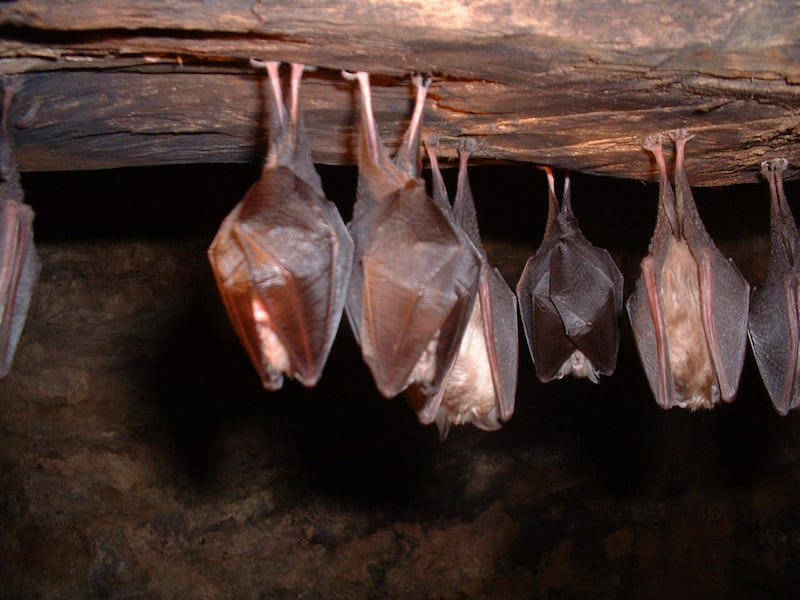The bats are out in the evening again. Their chaotic flight pattern appears uniquely distinct from birds; every flap seems frantic, as if the bats could drop out of the sky at any moment. Their frenzied style is almost comical when those supreme aerial performers, the swifts, arrive in the first week of May.
I recall one evening last year watching four swifts effortlessly swoop and loop across the evening sky in pursuit of prey. And then, occupying an aerial space just below them, two bats frenetically twisted left and right in an utterly nonsensical pattern. It was like watching a performance of the Bolshoi Ballet interrupted by two large drunken revellers stumbling around on stage.
Comparing the flight of bats with swifts is unfair, though; their unpredictable zigzag flight pattern frequently follows the exact same movements of the airborne insects they are chasing. It’s also impressive to think that one of the bats I saw that evening was likely a pregnant female who would have been weeks away from giving birth – upside down – to a blind and bare pup.
Maternal bats will find warm spaces to roost while nursing their young. They suckle their babies with milk for about a month in the summer before the juveniles are old enough to take to the air and find their food. The females mate in autumn and store the sperm in their uterine tract until the following spring, when they release it to fertilise their eggs. As the temperatures drop and days shorten, having spent weeks feeding and fattening up, bats begin hibernating in late October before emerging in March.
READ MORE
At least that’s how it’s supposed to go. But with our milder and shorter winters arising from climate warming some bat species are being forced to change their ways. Many now don’t need to fatten up in autumn because the hibernation period has shortened.
In a recent study published in Scientific Reports, biologists from the University of Barcelona examined a colony of 17,000 common bent-wing bats in Catalonia. They discovered that fat reserves accumulated at the start of hibernation have decreased significantly over the past two decades, which suggests that bats are rapidly adapting to a warmer climate. The concern is whether thinner female bats can reproduce successfully in spring and whether there will be enough insects to eat simultaneously.
Twenty years ago in southwest Cork I witnessed the impact of warming temperatures on hibernating bats. One warm afternoon in late October I met ecologist and bat expert Conor Kelleher in a rocky field. Standing over a small hole in the rocks, he convinced me – a claustrophobe at the best of times – to follow him through the gap and down underground.
I squeezed between the rocks, which opened into a large cave. It felt like a different world: dark, quiet and cool. Conor shone his torch on the cave roof, where we expected to see a roost of hibernating bats. Instead a small number were hanging upside down, some of them still awake. Conor said the higher temperatures were confusing them; they were either still outside hunting insects or had moved into the cave to begin hibernation but the temperatures were not low enough for them to sink into complete torpor.

Conor has spent his life observing bats. He saw his first bat when he was nine years old, staying overnight at his granny’s house in Ballyvourney, Cork; she let him stay up late enough to see them flying around the yard. He was hooked. As a young adult he moved to England and trained as an ecologist with one of the UK’s foremost bat experts. Returning to Ireland a few years later, he was pivotal in setting up Bat Conservation Ireland in 2004, a group of more than 700 volunteers trained to undertake bat surveys and monitor nationwide. All their results are added to a dataset held by the National Biodiversity Data Centre.
In his home village of Ballyvourney, Conor was instrumental in saving Cascade Wood from destruction when in 2006 a bypass was planned through it. It’s a semi-native woodland with a range of uniquely Irish species. It is home to the Bohill river, a tributary of the Sullane, An Sulán, which still hosts a small population of the critically endangered freshwater pearl mussel.
Cascade Wood is now a valued space used by locals and tourists; notably for Conor seven bat species use the area as their feeding ground.
Although bats will roost in all kinds of spaces – from rocks, scree slopes and exposed limestone to holes in old oaks and even young birch trees just six inches wide – they tend to favour buildings. Beside Cascade Wood is a former 1930s boarding school, Coláiste Íosagáin, which has been derelict for decades. Given its proximity to the woodland it’s not surprising that bats made the building their home, and it is now the site of Cork’s largest maternity roost of lesser horseshoe bats.
A major regeneration project is under way to turn the school into a digital hub and exhibition space. Luckily for the bats Conor is an ecological consultant on the project. When it was derelict the bats used all parts of the building, including the lower rooms and the underground tunnels. Under Conor’s guidance they are now corralled into the attic; bats are happy there as long as they have access – a centimetre gap is enough – and the insulation and damp-proof membranes used are bat-friendly.
The hope is that this renovated building will be a shared space for humans and bats, located beside a rescued and much-loved woodland. If this comes to pass it will prove what Conor Kelleher has long said: that nature and infrastructure development are not mutually exclusive. With some thought we can always make better choices for everyone’s benefit.
Join us for The Irish Times Inside Politics podcast live in Belfast on April 10th
Sign up for push alerts and have the best news, analysis and comment delivered directly to your phone
Find The Irish Times on WhatsApp and stay up to date




















